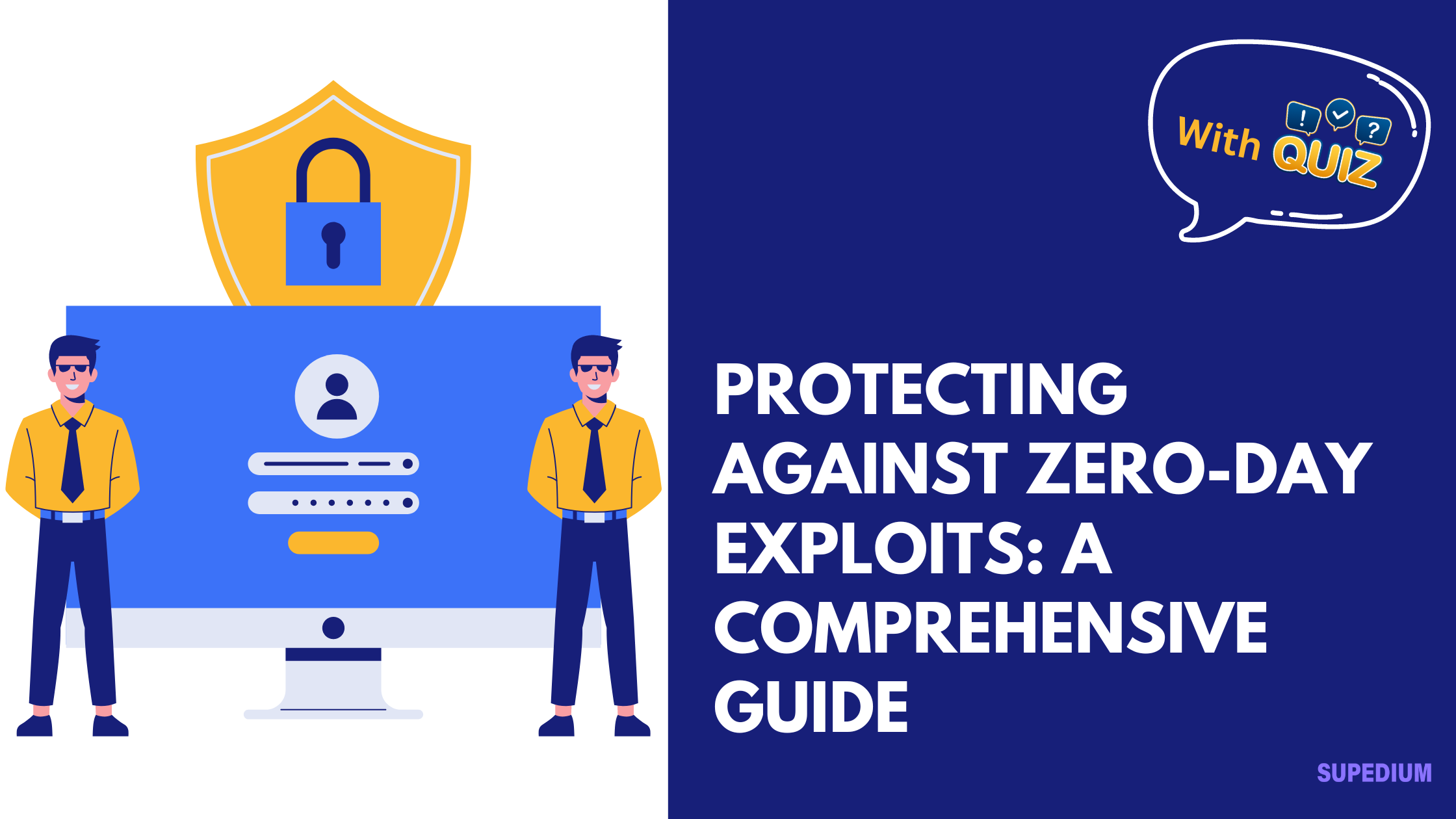Table of Contents
- 0.0.1 I. Introduction
- 0.0.2 II. Understanding Zero-Day Exploits
- 0.0.3 III. Risk Assessment and Management
- 0.0.4 IV. Preventive Measures
- 0.0.5 V. Detection Strategies
- 0.0.6 VI. Response and Mitigation
- 0.0.7 VII. Post-Incident Analysis
- 0.0.8 VIII. Emerging Trends and Challenges
- 0.0.9 IX. Resources and Tools
- 0.0.10 X. Conclusion
- 1 Quiz Time
![]()
In the ever-evolving landscape of cybersecurity, zero-day exploits represent one of the most elusive and dangerous threats. This article provides an in-depth exploration of zero-day exploits, including their nature, risks, and strategies for protection. By understanding these aspects, organizations and individuals can better safeguard their systems and data against these insidious attacks.
I. Introduction
Definition of Zero-Day Exploits
Zero-day exploits refer to attacks that target vulnerabilities in software or hardware that are unknown to the vendor or the public. The term “zero-day” denotes that the exploit takes advantage of a vulnerability on the very day it is discovered, before developers have had a chance to issue a fix or patch. Unlike known vulnerabilities, zero-day exploits can be particularly damaging due to the lack of available defenses at the time of discovery.
Importance of Addressing Zero-Day Exploits
Zero-day exploits can have severe consequences for both organizations and individuals. They can lead to unauthorized access to sensitive data, system outages, and substantial financial losses. For instance, the WannaCry ransomware attack of 2017 exploited a zero-day vulnerability in Microsoft Windows, affecting thousands of organizations globally and causing billions of dollars in damage.
II. Understanding Zero-Day Exploits
How Zero-Day Exploits Work
Zero-day exploits are often developed when attackers discover a vulnerability that has not yet been publicly disclosed. Once identified, the exploit is crafted to take advantage of this security gap, and it may be deployed through various methods, such as phishing emails, malicious websites, or infected software updates. The primary challenge with zero-day exploits is their stealthy nature—since the vulnerability is unknown, conventional security tools may not detect or prevent the attack.
Common Targets
Zero-day exploits can target a wide range of systems:
- Operating Systems: Attackers frequently target OS vulnerabilities to gain control over entire systems.
- Applications and Software: Vulnerabilities in widely-used applications can be exploited to access or manipulate data.
- Hardware Components: Hardware vulnerabilities can be exploited to bypass security controls and access critical systems.
III. Risk Assessment and Management
Identifying Potential Vulnerabilities
Effective protection against zero-day exploits begins with proactive risk management:
- Regular Vulnerability Assessments: Routine assessments can help identify potential weaknesses in systems and applications, even if they are not zero-day vulnerabilities.
- Threat Intelligence and Monitoring: Staying informed about emerging threats and vulnerabilities through threat intelligence services can aid in anticipating potential zero-day exploits.
Evaluating Impact and Likelihood
Understanding the potential impact and likelihood of a zero-day exploit is crucial for prioritizing response efforts:
- Business Impact Analysis: Assessing the potential damage an exploit could cause to business operations helps in allocating resources effectively.
- Prioritization of Vulnerabilities: Focusing on vulnerabilities that pose the highest risk ensures that organizations address the most critical threats first.
IV. Preventive Measures
Implementing Strong Security Practices
Preventive measures are essential in mitigating the risks associated with zero-day exploits:
- Regular Software Updates and Patch Management: Keeping software and systems updated with the latest patches is one of the most effective ways to close known vulnerabilities and reduce the risk of exploitation.
- Using Robust Security Configurations: Implementing strong security configurations and hardening systems can help minimize the attack surface.
Application Security
Securing applications is a key component of overall cybersecurity:
- Secure Coding Practices: Developers should adhere to secure coding guidelines to minimize vulnerabilities during the development process.
- Regular Security Testing: Conducting security testing, including static and dynamic analysis, helps identify and address potential vulnerabilities before they can be exploited.
Network Security
Network defenses are crucial in protecting against zero-day exploits:
- Firewalls and Intrusion Detection Systems: Firewalls and intrusion detection systems can help prevent unauthorized access and detect suspicious activity.
- Network Segmentation and Least Privilege Principles: Segmenting networks and applying least privilege principles help limit the potential impact of an exploit.
V. Detection Strategies
Anomaly Detection
Detecting zero-day exploits often requires advanced techniques:
- Monitoring Unusual Behavior: Anomaly detection systems can identify unusual patterns of activity that may indicate the presence of an exploit.
- Using Machine Learning and Behavioral Analytics: Machine learning algorithms and behavioral analytics can enhance the ability to detect and respond to novel threats.
Threat Intelligence Integration
Leveraging threat intelligence can improve detection capabilities:
- Leveraging Threat Feeds and Security Advisories: Integrating threat intelligence feeds and security advisories into security operations helps keep abreast of new threats and vulnerabilities.
- Collaboration with Information Sharing and Analysis Centers (ISACs): Collaborating with ISACs can provide valuable insights and early warnings about emerging threats.
VI. Response and Mitigation
Incident Response Plan
Having a well-defined incident response plan is essential for addressing zero-day exploits:
- Developing and Maintaining an Incident Response Plan: An effective incident response plan outlines procedures for detecting, responding to, and recovering from security incidents.
- Training and Simulation Exercises: Regular training and simulation exercises help ensure that response teams are prepared to handle real-world attacks.
Mitigation Techniques
When a zero-day exploit is identified, mitigation measures are crucial:
- Workarounds and Temporary Fixes: Implementing temporary fixes or workarounds can help mitigate the impact until a permanent solution is available.
- Coordinating with Vendors and Security Communities: Engaging with vendors and the broader security community can facilitate quicker resolution and information sharing.
VII. Post-Incident Analysis
Forensics and Investigation
Post-incident analysis is critical for understanding and improving security:
- Collecting and Analyzing Evidence: Gathering evidence from the incident helps in understanding the attack vector and methods used.
- Understanding Attack Vectors and Methods: Analyzing how the exploit was used can provide insights into preventing future incidents.
Improving Security Posture
Post-incident review should lead to improvements:
- Updating Security Policies and Procedures: Revising security policies and procedures based on lessons learned helps strengthen defenses.
- Implementing Lessons Learned from Incidents: Applying insights from past incidents enhances overall security posture and resilience.
VIII. Emerging Trends and Challenges
Advances in Exploit Techniques
The methods used in zero-day exploits are continually evolving:
- Evolution of Attack Methods: Attackers are constantly developing new techniques, making it essential to stay informed about emerging threats.
- Emerging Technologies and Their Impact on Security: Advances in technology, such as quantum computing and AI, may impact the nature of zero-day threats and defenses.
Future Directions in Zero-Day Protection
Looking ahead, several trends may shape zero-day protection strategies:
- Advances in Automated Defenses: Automation and AI are expected to play a significant role in detecting and responding to zero-day exploits.
- Role of Artificial Intelligence and Machine Learning: AI and machine learning will continue to enhance the ability to identify and mitigate zero-day threats.
IX. Resources and Tools
Security Tools and Technologies
Utilizing the right tools is essential for effective protection:
- Vulnerability Scanners and Patch Management Solutions: These tools help identify and address vulnerabilities before they can be exploited.
- Security Information and Event Management (SIEM) Systems: SIEM systems provide comprehensive monitoring and analysis of security events.
Training and Awareness Programs
Education and awareness are key components of a strong security posture:
- Security Awareness Training for Employees: Training employees on security best practices can reduce the risk of falling victim to zero-day exploits.
- Continuing Education and Certifications for IT Professionals: Ongoing education and professional certifications help IT professionals stay current with emerging threats and technologies.
X. Conclusion
Summary of Key Points
Zero-day exploits pose a significant threat to cybersecurity due to their ability to exploit unknown vulnerabilities. Effective protection involves a combination of preventive measures, detection strategies, and responsive actions.
The Ongoing Nature of Zero-Day Threats
Zero-day threats are a persistent challenge in cybersecurity. Continuous vigilance, proactive risk management, and staying informed about emerging trends are essential for mitigating these risks.
Call to Action
Organizations and individuals must take a proactive approach to security by implementing robust protective measures, staying informed about new threats, and collaborating with the broader security community to enhance resilience against zero-day exploits. By doing so, they can better safeguard their systems and data from these dangerous attacks.






Be the first to comment